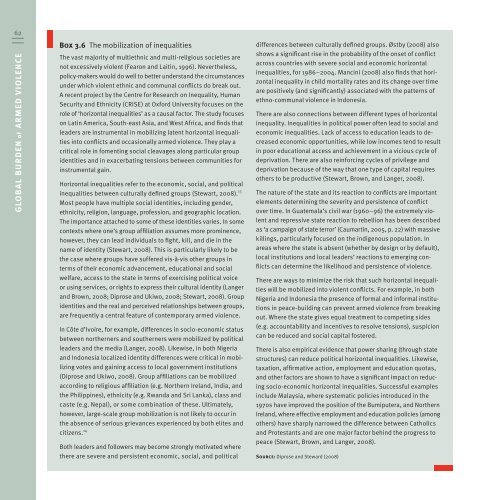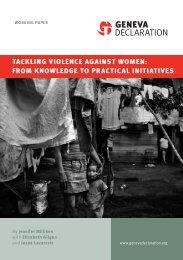Global Burden of Armed Violence - The Geneva Declaration on ...
Global Burden of Armed Violence - The Geneva Declaration on ...
Global Burden of Armed Violence - The Geneva Declaration on ...
You also want an ePaper? Increase the reach of your titles
YUMPU automatically turns print PDFs into web optimized ePapers that Google loves.
62<br />
GLOBAL BURDEN <str<strong>on</strong>g>of</str<strong>on</strong>g> ARMED VIOLENCE<br />
Box 3.6 <str<strong>on</strong>g>The</str<strong>on</strong>g> mobilizati<strong>on</strong> <str<strong>on</strong>g>of</str<strong>on</strong>g> inequalities<br />
<str<strong>on</strong>g>The</str<strong>on</strong>g> vast majority <str<strong>on</strong>g>of</str<strong>on</strong>g> multiethnic and multi-religious societies are<br />
not excessively violent (Fear<strong>on</strong> and Laitin, 1996). Nevertheless,<br />
policy-makers would do well to better understand the circumstances<br />
under which violent ethnic and communal c<strong>on</strong>flicts do break out.<br />
A recent project by the Centre for Research <strong>on</strong> Inequality, Human<br />
Security and Ethnicity (CRISE) at Oxford University focuses <strong>on</strong> the<br />
role <str<strong>on</strong>g>of</str<strong>on</strong>g> ‘horiz<strong>on</strong>tal inequalities’ as a causal factor. <str<strong>on</strong>g>The</str<strong>on</strong>g> study focuses<br />
<strong>on</strong> Latin America, South-east Asia, and West Africa, and finds that<br />
leaders are instrumental in mobilizing latent horiz<strong>on</strong>tal inequalities<br />
into c<strong>on</strong>flicts and occasi<strong>on</strong>ally armed violence. <str<strong>on</strong>g>The</str<strong>on</strong>g>y play a<br />
critical role in fomenting social cleavages al<strong>on</strong>g particular group<br />
identities and in exacerbating tensi<strong>on</strong>s between communities for<br />
instrumental gain.<br />
Horiz<strong>on</strong>tal inequalities refer to the ec<strong>on</strong>omic, social, and political<br />
inequalities between culturally defined groups (Stewart, 2008). 13<br />
Most people have multiple social identities, including gender,<br />
ethnicity, religi<strong>on</strong>, language, pr<str<strong>on</strong>g>of</str<strong>on</strong>g>essi<strong>on</strong>, and geographic locati<strong>on</strong>.<br />
<str<strong>on</strong>g>The</str<strong>on</strong>g> importance attached to some <str<strong>on</strong>g>of</str<strong>on</strong>g> these identities varies. In some<br />
c<strong>on</strong>texts where <strong>on</strong>e’s group affiliati<strong>on</strong> assumes more prominence,<br />
however, they can lead individuals to fight, kill, and die in the<br />
name <str<strong>on</strong>g>of</str<strong>on</strong>g> identity (Stewart, 2008). This is particularly likely to be<br />
the case where groups have suffered vis-à-vis other groups in<br />
terms <str<strong>on</strong>g>of</str<strong>on</strong>g> their ec<strong>on</strong>omic advancement, educati<strong>on</strong>al and social<br />
welfare, access to the state in terms <str<strong>on</strong>g>of</str<strong>on</strong>g> exercising political voice<br />
or using services, or rights to express their cultural identity (Langer<br />
and Brown, 2008; Diprose and Ukiwo, 2008; Stewart, 2008). Group<br />
identities and the real and perceived relati<strong>on</strong>ships between groups,<br />
are frequently a central feature <str<strong>on</strong>g>of</str<strong>on</strong>g> c<strong>on</strong>temporary armed violence.<br />
In Côte d’Ivoire, for example, differences in socio-ec<strong>on</strong>omic status<br />
between northerners and southerners were mobilized by political<br />
leaders and the media (Langer, 2008). Likewise, in both Nigeria<br />
and Ind<strong>on</strong>esia localized identity differences were critical in mobilizing<br />
votes and gaining access to local government instituti<strong>on</strong>s<br />
(Diprose and Ukiwo, 2008). Group affiliati<strong>on</strong>s can be mobilized<br />
according to religious affiliati<strong>on</strong> (e.g. Northern Ireland, India, and<br />
the Philippines), ethnicity (e.g. Rwanda and Sri Lanka), class and<br />
caste (e.g. Nepal), or some combinati<strong>on</strong> <str<strong>on</strong>g>of</str<strong>on</strong>g> these. Ultimately,<br />
however, large-scale group mobilizati<strong>on</strong> is not likely to occur in<br />
the absence <str<strong>on</strong>g>of</str<strong>on</strong>g> serious grievances experienced by both elites and<br />
citizens. 14<br />
Both leaders and followers may become str<strong>on</strong>gly motivated where<br />
there are severe and persistent ec<strong>on</strong>omic, social, and political<br />
differences between culturally defined groups. Østby (2008) also<br />
shows a significant rise in the probability <str<strong>on</strong>g>of</str<strong>on</strong>g> the <strong>on</strong>set <str<strong>on</strong>g>of</str<strong>on</strong>g> c<strong>on</strong>flict<br />
across countries with severe social and ec<strong>on</strong>omic horiz<strong>on</strong>tal<br />
inequalities, for 1986–2004. Mancini (2008) also finds that horiz<strong>on</strong>tal<br />
inequality in child mortality rates and its change over time<br />
are positively (and significantly) associated with the patterns <str<strong>on</strong>g>of</str<strong>on</strong>g><br />
ethno-communal violence in Ind<strong>on</strong>esia.<br />
<str<strong>on</strong>g>The</str<strong>on</strong>g>re are also c<strong>on</strong>necti<strong>on</strong>s between different types <str<strong>on</strong>g>of</str<strong>on</strong>g> horiz<strong>on</strong>tal<br />
inequality. Inequalities in political power <str<strong>on</strong>g>of</str<strong>on</strong>g>ten lead to social and<br />
ec<strong>on</strong>omic inequalities. Lack <str<strong>on</strong>g>of</str<strong>on</strong>g> access to educati<strong>on</strong> leads to decreased<br />
ec<strong>on</strong>omic opportunities, while low incomes tend to result<br />
in poor educati<strong>on</strong>al access and achievement in a vicious cycle <str<strong>on</strong>g>of</str<strong>on</strong>g><br />
deprivati<strong>on</strong>. <str<strong>on</strong>g>The</str<strong>on</strong>g>re are also reinforcing cycles <str<strong>on</strong>g>of</str<strong>on</strong>g> privilege and<br />
deprivati<strong>on</strong> because <str<strong>on</strong>g>of</str<strong>on</strong>g> the way that <strong>on</strong>e type <str<strong>on</strong>g>of</str<strong>on</strong>g> capital requires<br />
others to be productive (Stewart, Brown, and Langer, 2008).<br />
<str<strong>on</strong>g>The</str<strong>on</strong>g> nature <str<strong>on</strong>g>of</str<strong>on</strong>g> the state and its reacti<strong>on</strong> to c<strong>on</strong>flicts are important<br />
elements determining the severity and persistence <str<strong>on</strong>g>of</str<strong>on</strong>g> c<strong>on</strong>flict<br />
over time. In Guatemala’s civil war (1960–96) the extremely violent<br />
and repressive state reacti<strong>on</strong> to rebelli<strong>on</strong> has been described<br />
as ‘a campaign <str<strong>on</strong>g>of</str<strong>on</strong>g> state terror’ (Caumartin, 2005, p. 22) with massive<br />
killings, particularly focused <strong>on</strong> the indigenous populati<strong>on</strong>. In<br />
areas where the state is absent (whether by design or by default),<br />
local instituti<strong>on</strong>s and local leaders’ reacti<strong>on</strong>s to emerging c<strong>on</strong>flicts<br />
can determine the likelihood and persistence <str<strong>on</strong>g>of</str<strong>on</strong>g> violence.<br />
<str<strong>on</strong>g>The</str<strong>on</strong>g>re are ways to minimize the risk that such horiz<strong>on</strong>tal inequalities<br />
will be mobilized into violent c<strong>on</strong>flicts. For example, in both<br />
Nigeria and Ind<strong>on</strong>esia the presence <str<strong>on</strong>g>of</str<strong>on</strong>g> formal and informal instituti<strong>on</strong>s<br />
in peace-building can prevent armed violence from breaking<br />
out. Where the state gives equal treatment to competing sides<br />
(e.g. accountability and incentives to resolve tensi<strong>on</strong>s), suspici<strong>on</strong><br />
can be reduced and social capital fostered.<br />
<str<strong>on</strong>g>The</str<strong>on</strong>g>re is also empirical evidence that power sharing (through state<br />
structures) can reduce political horiz<strong>on</strong>tal inequalities. Likewise,<br />
taxati<strong>on</strong>, affirmative acti<strong>on</strong>, employment and educati<strong>on</strong> quotas,<br />
and other factors are shown to have a significant impact <strong>on</strong> reducing<br />
socio-ec<strong>on</strong>omic horiz<strong>on</strong>tal inequalities. Successful examples<br />
include Malaysia, where systematic policies introduced in the<br />
1970s have improved the positi<strong>on</strong> <str<strong>on</strong>g>of</str<strong>on</strong>g> the Bumiputera, and Northern<br />
Ireland, where effective employment and educati<strong>on</strong> policies (am<strong>on</strong>g<br />
others) have sharply narrowed the difference between Catholics<br />
and Protestants and are <strong>on</strong>e major factor behind the progress to<br />
peace (Stewart, Brown, and Langer, 2008).<br />
Source: Diprose and Steward (2008)









